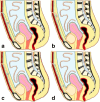The urachus revisited: multimodal imaging of benign & malignant urachal pathology
- PMID: 32045264
- PMCID: PMC10993214
- DOI: 10.1259/bjr.20190118
The urachus revisited: multimodal imaging of benign & malignant urachal pathology
Abstract
The urachus is a fibrous tube extending from the umbilicus to the anterosuperior bladder dome that usually obliterates at week 12 of gestation, becoming the median umbilical ligament. Urachal pathology occurs when there is incomplete obliteration of this channel during foetal development, resulting in the formation of a urachal cyst, patent urachus, urachal sinus or urachal diverticulum. Patients with persistent urachal remnants may be asymptomatic or present with lower abdominal or urinary tract symptoms and can develop complications. The purpose of this review is to describe imaging features of urachal remnant pathology and potential benign and malignant complications on ultrasound, CT, positron emission tomography CT and MRI.
Figures














References
-
- JS Y, Kim KW, Lee HJ, Lee YJ, Yoon CS, Kim MJ . Urachal remnant diseases: spectrum of CT and US findings . RadioGraphics 2001. ; 2: 451 – 61 . - PubMed
Publication types
MeSH terms
Grants and funding
LinkOut - more resources
Full Text Sources

